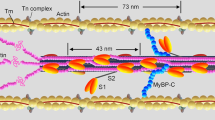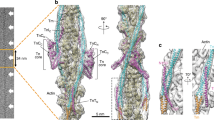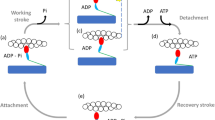Abstract
Contraction of both skeletal muscle and the heart is thought to be controlled by a calcium-dependent structural change in the actin-containing thin filaments, which permits the binding of myosin motors from the neighbouring thick filaments to drive filament sliding1,2,3. Here we show by synchrotron small-angle X-ray diffraction of frog (Rana temporaria) single skeletal muscle cells that, although the well-known thin-filament mechanism is sufficient for regulation of muscle shortening against low load, force generation against high load requires a second permissive step linked to a change in the structure of the thick filament. The resting (switched ‘OFF’) structure of the thick filament is characterized by helical tracks of myosin motors on the filament surface and a short backbone periodicity2,4,5. This OFF structure is almost completely preserved during low-load shortening, which is driven by a small fraction of constitutively active (switched ‘ON’) myosin motors outside thick-filament control. At higher load, these motors generate sufficient thick-filament stress to trigger the transition to its long-periodicity ON structure, unlocking the major population of motors required for high-load contraction. This concept of the thick filament as a regulatory mechanosensor provides a novel explanation for the dynamic and energetic properties of skeletal muscle. A similar mechanism probably operates in the heart.
This is a preview of subscription content, access via your institution
Access options
Subscribe to this journal
Receive 51 print issues and online access
$199.00 per year
only $3.90 per issue
Buy this article
- Purchase on Springer Link
- Instant access to full article PDF
Prices may be subject to local taxes which are calculated during checkout




Similar content being viewed by others
References
Gordon, A. M., Homsher, E. & Regnier, M. Regulation of contraction in striated muscle. Physiol. Rev. 80, 853–924 (2000)
Huxley, H. E. & Brown, W. The low-angle X-ray diagram of vertebrate striated muscle and its behaviour during contraction and rigor. J. Mol. Biol. 30, 383–434 (1967)
Reconditi, M. et al. Motion of myosin head domains during activation and force development in skeletal muscle. Proc. Natl Acad. Sci. USA 108, 7236–7240 (2011)
Haselgrove, J. C. X-ray evidence for conformational changes in the myosin filaments of vertebrate striated muscle. J. Mol. Biol. 92, 113–143 (1975)
Woodhead, J. L. et al. Atomic model of a myosin filament in the relaxed state. Nature 436, 1195–1199 (2005)
Luther, P. K. et al. Direct visualization of myosin-binding protein C bridging myosin and actin filaments in intact muscle. Proc. Natl Acad. Sci. USA 108, 11423–11428 (2011)
Stewart, M. A., Franks-Skiba, K., Chen, S. & Cooke, R. Myosin ATP turnover rate is a mechanism involved in thermogenesis in resting skeletal muscle fibers. Proc. Natl Acad. Sci. USA 107, 430–435 (2010)
Linari, M. et al. Interference fine structure and sarcomere length dependence of the axial x-ray pattern from active single muscle fibers. Proc. Natl Acad. Sci. USA 97, 7226–7231 (2000)
Reconditi, M. et al. Sarcomere-length dependence of myosin filament structure in skeletal muscle fibres of the frog. J. Physiol. (Lond.) 592, 1119–1137 (2014)
Irving, T. et al. Thick-filament strain and interfilament spacing in passive muscle: effect of titin-based passive tension. Biophys. J. 100, 1499–1508 (2011)
Caputo, C., Edman, K. A., Lou, F. & Sun, Y. B. Variation in myoplasmic Ca2+ concentration during contraction and relaxation studied by the indicator fluo-3 in frog muscle fibres. J. Physiol. (Lond.) 478, 137–148 (1994)
Yagi, N. An X-ray diffraction study on early structural changes in skeletal muscle contraction. Biophys. J. 84, 1093–1102 (2003)
Rome, E., Offer, G. & Pepe, F. A. X-ray diffraction of muscle labelled with antibody to C-protein. Nat. New Biol. 244, 152–154 (1973)
Reconditi, M. et al. The myosin motor in muscle generates a smaller and slower working stroke at higher load. Nature 428, 578–581 (2004)
Huxley, H., Reconditi, M., Stewart, A. & Irving, T. X-ray interference studies of crossbridge action in muscle contraction: evidence from quick releases. J. Mol. Biol. 363, 743–761 (2006)
Brunello, E. et al. Structural changes in the myosin filament and cross-bridges during active force development in single intact frog muscle fibres: stiffness and X-ray diffraction measurements. J. Physiol. (Lond.) 577, 971–984 (2006)
Piazzesi, G. et al. Skeletal muscle performance determined by modulation of number of myosin motors rather than motor force or stroke size. Cell 131, 784–795 (2007)
Lombardi, V. & Menchetti, G. The maximum velocity of shortening during the early phases of the contraction in frog single muscle fibres. J. Muscle Res. Cell Motil. 5, 503–513 (1984)
Bennett, P. M. & Gautel, M. Titin domain patterns correlate with the axial disposition of myosin at the end of the thick filament. J. Mol. Biol. 259, 896–903 (1996)
Jung, H. S., Komatsu, S., Ikebe, M. & Craig, R. Head–head and head–tail interaction: a general mechanism for switching off myosin II activity in cells. Mol. Biol. Cell 19, 3234–3242 (2008)
Pfuhl, M. & Gautel, M. Structure, interactions and function of the N-terminus of cardiac myosin binding protein C (MyBP-C): who does what, with what, and to whom? J. Muscle Res. Cell Motil. 33, 83–94 (2012)
Muhle-Goll, C. et al. Structural and functional studies of titin’s fn3 modules reveal conserved surface patterns and binding to myosin S1–a possible role in the Frank–Starling mechanism of the heart. J. Mol. Biol. 313, 431–447 (2001)
Brunello, E. et al. The contributions of filaments and cross-bridges to sarcomere compliance in skeletal muscle. J. Physiol. (Lond.) 592, 3881–3899 (2014)
Huxley, A. F. & Lombardi, V. A sensitive force transducer with resonant frequency 50 kHz. J. Physiol. (Lond.) 305, 15–6P (1980)
Huxley, A. F., Lombardi, V. & Peachey, L. D. A system for fast recording of longitudinal displacement of a striated muscle fibre. J. Physiol. (Lond.) 317, 12P–13P (1981)
Linari, M., Caremani, M., Piperio, C., Brandt, P. & Lombardi, V. Stiffness and fraction of myosin motors responsible for active force in permeabilized muscle fibers from rabbit psoas. Biophys. J. 92, 2476–2490 (2007)
Narayanan, T., Diat, O. & Boesecke, P. SAXS and USAXS on the high brilliance beamline at the ESRF. Nucl. Instrum. Methods Phys. Res. Sect. A 467–468, 1005–1009 (2001)
Acknowledgements
We thank M. Dolfi and J. Gorini for electronic and mechanical engineering support and P. Panine for assistance at the beamline. We thank ESRF for beamtime, and Ente Cassa di Risparmio di Firenze 2010.1402, FIRB-Futuro in Ricerca project RBFR08JAMZ, MIUR-PRIN project 2010R8JK2X (Italy), MRC (UK) and ESRF for financial support.
Author information
Authors and Affiliations
Contributions
M.L., E.B., M.R., L.F., M.C., G.P., V.L. and M.I. contributed to the conception and design of the experiments, the collection, analysis and interpretation of data, and drafting or critical revision of the article. T.N. contributed to data collection and analysis.
Corresponding author
Ethics declarations
Competing interests
The authors declare no competing financial interests.
Extended data figures and tables
Extended Data Figure 1 The increase in the spacing of the M6 reflection on activation is delayed by imposing a period of unloaded shortening.
The top traces show SM6 (circles) superimposed on force (continuous line); filled/open circles and thicker/thinner line denote data from fixed-end tetani and tetani with imposed shortening, respectively. The bottom traces show imposed length change (ΔL, expressed as percentage of initial fibre length (% L0)). X-ray data added from one/two repeats of the protocol in three muscle fibres.
Extended Data Figure 2 Stiffness changes during unloaded shortening.
a, Half-sarcomere stiffness (e) relative to that at the plateau of an isometric tetanus (e0), at different times after the start of unloaded shortening of 10% L0 applied at the tetanus plateau, calculated from the ratio of force and half-sarcomere length changes in response to 0.2% L0 step stretches complete in 100 μs. Mean ± s.e.m. from four fibres; species, Rana esculenta, 4 °C; e0 = 0.27 ± 0.01 T0 nm−1; T0 = 137 ± 13 kPa. b, Fraction of myosin motors attached to actin (fA; thick solid line) and fractions with bound ATP (thin solid line) or ADP and inorganic phosphate (Pi) (dashed line) as a function of time during unloaded shortening, calculated from the kinetic model described in the Supplementary Discussion. c, Number of myosin motors attached to actin (n) relative to that at the plateau of an isometric tetanus (n0), at different times during unloaded shortening, calculated from e/e0 in a as described in the Supplementary Discussion. Mean ± s.e.m. from four fibres; s.e.m. includes the contribution of errors in measured values of filament and parallel elasticity. The thick line was calculated by normalizing fA in b for its tetanus plateau value.
Extended Data Figure 3 Changes in the intensity, spacing and interference fine structure of the M3 reflection associated with a period of unloaded shortening.
Top, sarcomere length change in nanometres per half-sarcomere. a–c, Changes in intensity (IM3; a), spacing (SM3; b) and interference fine structure (LM3; c) (circles) superimposed on force (continuous line). Horizontal dashed lines, resting value of X-ray parameter; vertical dashed lines, time of end of shortening. X-ray data added from three fibres. Filled/open circles denote data before/after the end of shortening.
Supplementary information
Supplementary Information
This file contains a Supplementary Discussion and additional references. (PDF 295 kb)
Rights and permissions
About this article
Cite this article
Linari, M., Brunello, E., Reconditi, M. et al. Force generation by skeletal muscle is controlled by mechanosensing in myosin filaments. Nature 528, 276–279 (2015). https://doi.org/10.1038/nature15727
Received:
Accepted:
Published:
Issue Date:
DOI: https://doi.org/10.1038/nature15727
This article is cited by
-
Mechanism of post-tetanic depression of slow muscle fibres
Journal of Comparative Physiology B (2024)
-
Exercise metabolism and adaptation in skeletal muscle
Nature Reviews Molecular Cell Biology (2023)
-
Eccentric muscle contractions: from single muscle fibre to whole muscle mechanics
Pflügers Archiv - European Journal of Physiology (2023)
-
A century of exercise physiology: key concepts in muscle energetics
European Journal of Applied Physiology (2023)
-
Sarcomere dynamics revealed by a myofilament integrated FRET-based biosensor in live skeletal muscle fibers
Scientific Reports (2022)
Comments
By submitting a comment you agree to abide by our Terms and Community Guidelines. If you find something abusive or that does not comply with our terms or guidelines please flag it as inappropriate.



